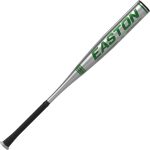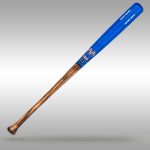College baseball generally uses metal bats, which offer greater power and durability compared to wooden bats. Metal bats have revolutionized the game and are widely used in college-level competitions.
In recent years, the use of metal bats in college baseball has sparked debates and discussions due to player safety concerns and the significant difference in performance compared to wooden bats. Metal bats are known to generate higher exit speeds, which increase the potential risk for infielders and pitchers.
However, the technological advancements in metal bat engineering have led to improved safety measures, such as the introduction of BBCOR (Batted Ball Coefficient of Restitution) bats that have more similar performance characteristics to wooden bats. These regulations aim to balance player safety with the advantages offered by metal bats in terms of power and durability. Overall, the use of metal bats in college baseball continues to be a subject of ongoing scrutiny and evaluation.

Credit: bleacherreport.com
History Of College Baseball Bats
College baseball bats have evolved over time, transitioning from wood to metal for increased power and performance. Today, metal bats are commonly used in college baseball games.
Early Years Of College Baseball
During the early years of college baseball, wooden bats were predominantly used by the players. These traditional bats were made from various types of wood, such as ash, maple, or hickory. The use of wooden bats added an element of skill and technique to the game, as players had to rely on their swing mechanics and timing to hit the ball effectively.Introduction Of Metal Bats
In the late 1970s, metal bats made their way into the world of college baseball. These bats were typically made from aluminum or alloy, which made them much lighter and more durable compared to their wooden counterparts. The introduction of metal bats brought about significant changes to the game, both in terms of performance and safety.Advantages And Disadvantages Of Metal Bats
Metal bats have their fair share of advantages and disadvantages in college baseball. Let’s take a closer look at both sides: Advantages of metal bats:- Metal bats provide increased bat speed, allowing players to generate more power when hitting the ball.
- They have a larger sweet spot, which means players have a better chance of making solid contact with the ball and getting a hit.
- Unlike wooden bats, metal bats do not break easily, making them more cost-effective for college teams.
- They require less maintenance compared to wooden bats.
- Metal bats can maintain consistent performance in various weather conditions.
- Metal bats have been criticized for their “ping” sound, which some argue takes away from the traditional “crack” sound of a wooden bat.
- The increased ball speed off the bat can pose a safety concern for pitchers and fielders, as they have less time to react to line drives.
- Some players believe that metal bats contribute to a decrease in the skill level required to excel in the game.
- The lighter weight of metal bats may lead to players developing improper swing mechanics or relying too much on bat speed rather than proper technique.
Current Rules And Regulations
College baseball abides by specific rules and regulations regarding the use of metal bats. These guidelines ensure fair play and safety for all players involved.
Ncaa Regulations
The National Collegiate Athletic Association (NCAA) is the governing body for college baseball in the United States. When it comes to the use of metal bats, the NCAA has specific regulations in place to ensure fair play and player safety. One of the most important regulations set by the NCAA is the restriction on the composition of metal bats. These bats must be made from a combination of aluminum and other metals, ensuring durability without compromising safety. It is important to note that the use of wooden bats is not permitted in college baseball, unlike in professional baseball.Banned Metal Bats
While metal bats are allowed in college baseball, certain types of metal bats have been banned due to safety concerns. These banned bats are typically those that give hitters an unfair advantage by producing higher exit speeds, which pose a greater risk to pitchers and fielders. To prevent such bats from being used in games, the NCAA has established a certification process. Each bat must bear the stamp of certification, indicating that it has met the required performance standards and is approved for use in college baseball. This ensures that all players have access to bats that meet the safety requirements set by the NCAA.Specifications And Performance Standards
The NCAA has set specific specifications and performance standards for metal bats used in college baseball. These standards ensure that the bats perform in a manner similar to wooden bats, preventing an excessive amount of power being generated by the hitter. One of the most significant specifications is the “bat exit speed ratio” (BESR), which limits the speed at which a baseball can leave the bat. The BESR is designed to mimic the performance of a wooden bat and ensures a level playing field for both pitchers and hitters. Moreover, the NCAA also conducts tests to determine the “ball exit speed ratio” (BESR) of each metal bat. If a bat exceeds the specified limit, it will be deemed illegal and cannot be used in college baseball games. To summarize, college baseball adheres to specific rules and regulations set by the NCAA regarding the use of metal bats. These regulations include the composition of the bats, the certification process, and the specifications and performance standards. By enforcing these rules, the NCAA aims to maintain fairness and safety in the game of college baseball.Debate On Metal Bats In College Baseball
College baseball continues to debate the use of metal bats on the field. The controversy centers around whether or not metal bats should be allowed in college-level competition.
Safety Concerns
College baseball teams have long been divided over the use of metal bats due to safety concerns. Metal bats are known for their increased exit velocity, meaning the ball travels faster off the bat compared to wooden bats. While this may make the game more exciting for spectators, it also raises safety concerns for the players. Opponents argue that the higher ball speed poses a greater risk for pitchers and infielders who have less time to react to line drives. In fact, several incidents of serious injuries caused by line drives in college baseball have fueled the debate on banning metal bats altogether. Proponents of metal bats, on the other hand, contend that the increased durability and pop of these bats actually reduce the chances of shattered bats, which can pose their own safety risks. It is certainly a complex issue with valid arguments on both sides.Effect On Game Strategy
The debate on metal bats in college baseball also encompasses the effect on game strategy. The differences between metal and wooden bats go beyond just the sound they make upon contact. With metal bats, players are able to achieve higher exit velocities, resulting in more home runs and extra-base hits. This has led to a shift in game strategy, as coaches and players have had to adjust their approach to pitching, defense, and even base running. For instance, pitchers may be more cautious about throwing inside, fearing that a line drive could quickly head back at them. Defensively, infielders need to react quickly to hard-hit grounders, while outfielders need to track deep fly balls that may carry further with a metal bat. On the offensive side, hitters may look to take advantage of the bat’s power potential by being more aggressive at the plate. The effect of metal bats on game strategy has sparked discussions on how it may be changing the dynamics of college baseball and whether it is for better or worse.Player And Coach Perspectives
When it comes to the use of metal bats in college baseball, players and coaches have diverse perspectives on the matter. Some players enjoy the added power and distance that metal bats provide, as it allows them to showcase their hitting abilities and potentially attract the attention of professional scouts. The ability to consistently hit the ball harder and further can significantly impact a player’s statistics and overall performance. On the other hand, there are also players who prefer the traditional feel and sound of wooden bats. They believe that using wooden bats promotes a purer form of the game and requires more skill to achieve success at the plate. Additionally, some pitchers and infielders may feel safer with wooden bats in play, as it reduces the risk of line drives coming back at them at higher speeds. Coaches also have varying perspectives on metal bats. Some support the use of metal bats for the excitement it brings to the game and the potential to improve offensive performance. Others, however, are concerned about the safety implications and the impact on game strategy. They may favor the use of wooden bats to maintain a more traditional and balanced approach to college baseball. Overall, the debate on metal bats in college baseball reflects the clash between safety concerns, the effect on game strategy, and the perspectives of players and coaches. It is a topic that continues to generate discussions and may require further consideration to find the best solution for all parties involved.:format(jpeg)/cdn.vox-cdn.com/uploads/chorus_image/image/45613576/2850121.0.jpg)
Credit: www.bannersontheparkway.com

Credit: www.nytimes.com
Frequently Asked Questions On Does College Baseball Use Metal Bats?
Do College Baseball Players Use Metal Bats?
Yes, college baseball players typically use metal bats. Metal bats are lighter and offer more power and distance when hitting the ball.
Why Do College Baseball Players Use Metal Bats?
College baseball players use metal bats because they are more durable, provide better performance, and enhance the speed and power of the hits.
Are Metal Bats Safer Than Wooden Bats?
Metal bats are generally considered safer than wooden bats in college baseball. They have a larger sweet spot, reducing the risk of handle breakage and improving player safety.
How Do Metal Bats Compare To Wooden Bats In College Baseball?
Metal bats are preferred in college baseball due to their performance advantages. They allow for higher ball exit speeds and greater hitting distances compared to wooden bats.
Conclusion
College baseball has embraced the use of metal bats due to their durability and performance advantages. While wood bats are used in professional baseball, metal bats offer collegiate players a chance to showcase their power and hit the ball farther.
However, metal bats can also alter the dynamics of the game and lead to higher scoring. Ultimately, the use of metal bats in college baseball continues to be a subject of debate and discussion.

General Manager & Auditorial Head.
Killian Jake is a World Sports Traveler and hobbyist sports lover. By exploring different sorts of playing modules like indoor, outdoor, and many more. As for professionalism and writing, it’s helpful to give you the right suggestions on different games and sports.





